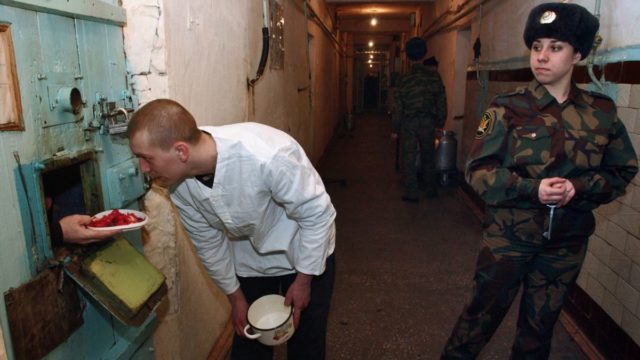
Authorities Alarmed by Reported Spread of Islamic Extremism in Russian Prisons
Publication: Eurasia Daily Monitor Volume: 17 Issue: 51
By:

On April 3, Russian news agencies reported that the country’s security services killed one and detained another member of an Islamic State (IS) cell in Stavropol Oblast. Russian officials alleged that members of the extremist group were preparing terrorist attacks in Stavropol as well as Khanty-Mansiysk Autonomous Okrug (KhMAO), in north-central Russia. One of them was a resident of Stavropol and the other came from neighboring Dagestan. The special operation took place in the city of Neftekumsk, which is located in the eastern part of the Stavropol region, in the vicinity of Dagestan. On that same day, the Federal Security Service (FSB) declared that it arrested three other people affiliated with the regional insurgent group the Caucasus Emirate in the city of Lyantor, KhMAO. The arrested individuals are suspected of planning a terrorist attack in the northern Russian town (TASS, April 3). KhMAO is known for having the largest oil extraction industry in Russia.
How the two above-mentioned incidents are related is unclear. The Islamic State and the Caucasus Emirate are competing organizations in the region rather than allies. Therefore, it is unlikely that members of the two organizations would cooperate to launch attacks. The Caucasus Emirate is a homegrown militant group dating back to 2007, which aims to create a separate state in the Russian North Caucasus. The IS is a global jihadist organization, although its regional offshoots often support local agendas. The IS arrived to the North Caucasus at the end of 2014 and immediately started to supplant the Caucasus Emirate. The Russian security services succeeded in largely suppressing both organizations over the past several years; today, these North Caucasus militant groups’ members are associated only with sporadic violence. As Kavkazsky Uzel points out, the last two insurgency-related incidents in Stavropol Oblast occurred a year apart (Kavkazsky Uzel, April 3).
Even though the overall levels of insurgent violence in the North Caucasus have been dramatically falling, some Russian officials believe that the Islamist militancy has shifted its activities to the country’s penitentiary system. In December 2019, the Russian Investigative Committee announced that in Kalmykia, investigators identified a terrorist organization that operated in Penal Colony #2. The extremist network had reportedly been in operation since 2013 and had at least 100 members. The Penal Colony’s leadership was also suspected of covering up for the local extremist group. Upon uncovering the network, authorities conducted searches at Colony #2 as well the private residences of the suspects and their relatives in Dagestan, Kabardino-Balkaria, Krasnodar and Volgograd regions. In addition, government agents searched the office of Viktor Grebennikov, the first deputy head of the Russian State Penitentiary Agency’s regional branch in Kalmykia (Kommersant, December 18, 2019).
Kalmykia is a Buddhist-majority republic, lying to the north of Dagestan and Stavropol. Recently, it became known for a series of mass public protests that broke out after authorities appointed a former official from the Russia-backed separatist territory of the Donetsk People’s Republic, in eastern Ukraine (BBC News—Russian service, October 23, 2019; see EDM, November 15, 2019).
Meanwhile, according to a source inside Kalmykia’s penitentiary system, quoted by Kavkazsky Uzel, prisoners of Penal Colony #2 first established a jamaat (a Muslim social support group that engages in joint religious worship and other activities) in 2010. From the outset, it operated as an ideological organization, working to indoctrinate its members in Islamist thought. Eventually, this Kalmykia prison jamaat transformed into a multi-ethnic group that was only nominally Islamic, although it retained a declarative affiliation with the Islamic State. Reportedly, the jamaat grew quite rich: its members made money by engaging in a variety of fraudulent activities. As a result, many inmates sought to join due to the organization’s abundance of resources. At the same time, the jamaat’s affiliation with extremist Islamic organizations, like the IS, was purely nominal, said the Kavkazsky Uzel source (Kavkazsky Uzel, April 1).
Harvard researcher of extremist organizations Vera Mironova told Kavkazsky Uzel that jamaats have become quite common in Russian penitentiaries. However, according to the academic, they encapsulate inmates’ responses to the rampant human rights abuses inside the Russian prison system. Their affiliation with the Islamic State and similar extremist groups is usually a symbolic act, with little or no bearing on these prison jamaat members’ everyday lives. Some experts contend that while it may be possible for the IS to carry out indoctrination and recruitment efforts inside Russian prisons, they doubt that the scale of such activities is significant. Other scholars argue that the radicalization of Muslims in Russian prisons is related to the instinctive fear that Islam and Muslims instill among penitentiary administrators, who are unprepared to grant religious freedoms and often try to suppress any Islamic religious activity among inmates. Rights activists say that the authorities’ reports about uncovering large-scale Islamist networks in the Russian prison system are part of the self-promotion of Russian security officials and have little to do with reality (Kavkazsky Uzel, April 1).
Although the activity of insurgency movements in the North Caucasus has evidently declined in the past several years, sporadic violence and systemic responses to human rights abuses have not disappeared. The systemic mistreatment of incarcerated individuals in Russia is especially glaring, and Islam provides a platform for disgruntled inmates to unite and protect themselves. In turn, Russian officials’ allegations that, in some instances, such self-support groups may be turning to political violence has yet to be openly substantiated.



